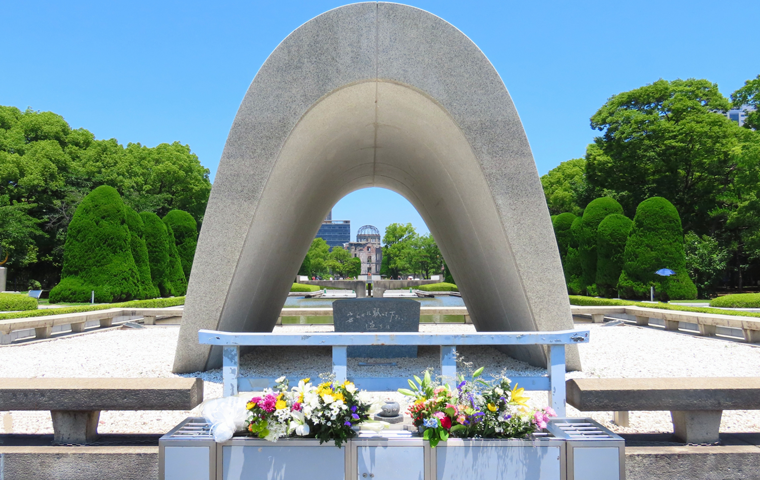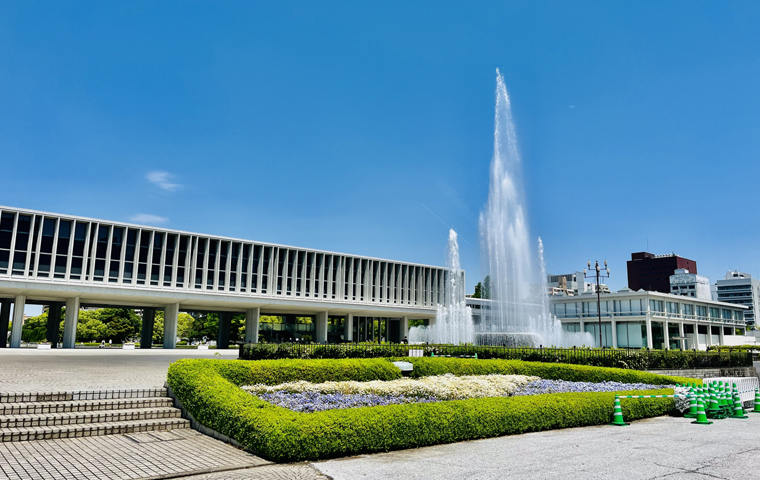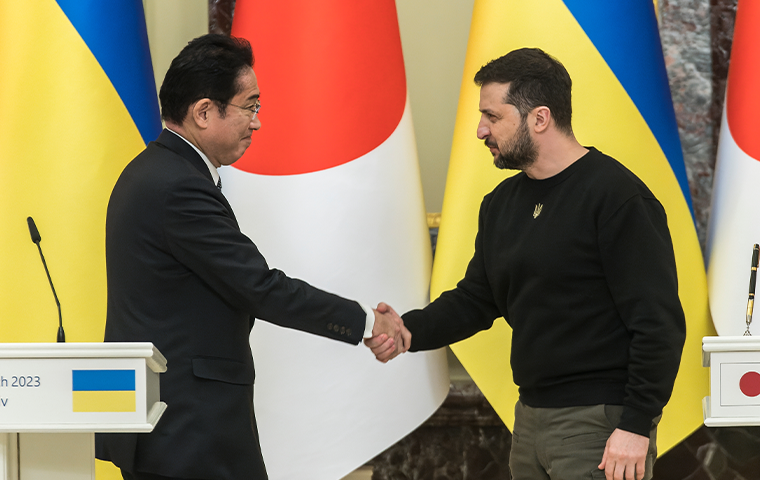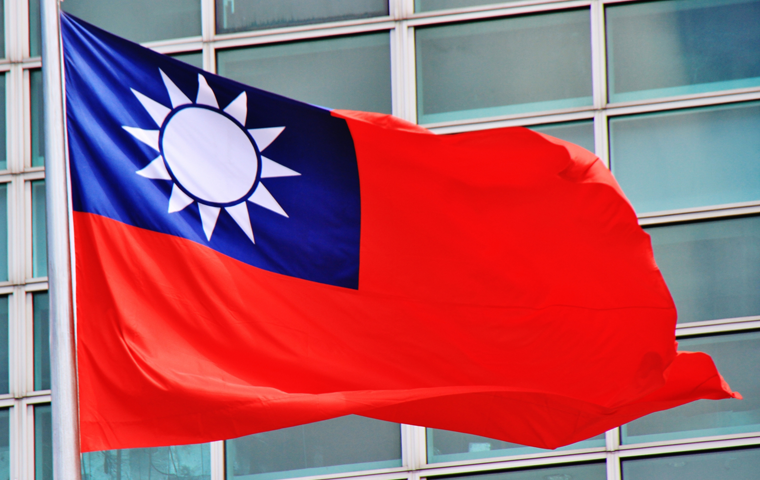80 Years Since the Atomic Bombing: Hiroshima’s Prayer and the World at a Crossroads
Related Articles
80 Years After the Bombing: A Ceremony That Weaves Memory

At 8:15 a.m. on August 6, 2025—the very moment when Hiroshima was reduced to ashes 80 years ago—the “Bell of Peace” tolled through the Hiroshima Peace Memorial Park. Attendees bowed their heads in silence as 4,940 new names were added to the memorial registry of victims, bringing the total to 349,246. The weight of that number deepened the quiet that enveloped the park.
This milestone year’s Peace Memorial Ceremony was more than a solemn remembrance—it was a declaration of Hiroshima’s enduring will in a world mired in turmoil. Over 120 nations and regions, the largest number ever, sent representatives to attend. Behind this unprecedented gathering lay a deft act of diplomacy by the city: instead of issuing traditional “invitations,” Hiroshima sent “notifications” to every nation and region maintaining diplomatic ties with Japan. This shift meant that even Russia (which ultimately did not attend) and the Palestinian Authority—unrecognized by Japan—were included, marking the first time a Palestinian representative took part.
As Mayor Kazumi Matsui explained, this approach encouraged each nation to decide for itself whether to “understand Hiroshima’s spirit and participate voluntarily.” In an age of intensifying geopolitical confrontation, this was a sophisticated, nonpartisan strategy—allowing Hiroshima to continue sending a universal message of peace without aligning itself politically.
In his address, Mayor Matsui posed a sharp question to world leaders: “Are policies relying on nuclear deterrence not, in fact, creating new conflicts between nations?” He urged them to visit Hiroshima and witness “the reality of the atomic bombing” firsthand.
Prime Minister Shigeru Ishiba expressed condolences to the victims and reaffirmed Japan’s mission, as “the only nation to have suffered atomic warfare,” to lead the pursuit of “a world without nuclear weapons.” Yet his roadmap was confined within the frameworks of the Nuclear Non-Proliferation Treaty (NPT) and Japan’s “Hiroshima Action Plan,” with no mention of the Treaty on the Prohibition of Nuclear Weapons (TPNW). This omission highlighted the widening gap between Hiroshima’s moral plea and Japan’s security policy.
At the close of the ceremony, white doves took flight, and local children delivered a heartfelt “Pledge for Peace.” Their voices echoed Hiroshima’s essential question: how can the memory and mission of this city be passed on to future generations?
Vanishing Witnesses and the Challenge of Inheritance
The significance of the 80th anniversary is sharpened by the aging population of the survivors themselves. According to Japan’s Ministry of Health, Labour and Welfare, as of March 2025, the number of living atomic bomb survivors holding health certificates fell below 100,000 for the first time—standing at 99,130—with an average age exceeding 86. The generation able to testify directly to the horrors of August 6, 1945, is quietly fading from the stage of history.
To counter this inevitable “erosion of memory,” Hiroshima has embarked on a profound and delicate effort: how to transmit not just facts, but the lived experience itself. At the forefront is the use of advanced technology. The city’s “Atomic Bomb Testimony Interactive System” is a landmark initiative. It allows users to ask questions to a life-sized image of a survivor displayed on screen; artificial intelligence analyzes the query and plays the most relevant recorded response from a vast archive of interviews. Importantly, this system avoids fabricating responses with generative AI—remaining faithful to the survivor’s actual words, expressions, and emotions. It aims not to replace the survivors but to serve as a bridge connecting their legacy to future generations.
Virtual reality programs also enable participants to experience Hiroshima’s transformation—from its pre-bombing cityscape through destruction and reconstruction—helping them grasp the scale of devastation beyond what words can convey. Yet technology alone cannot sustain memory. The heart of this challenge lies in human connection.
Initiatives like the Ministry of Foreign Affairs’ “Youth Special Communicators for a World Without Nuclear Weapons” encourage young people to hear survivors’ stories firsthand and become new messengers of peace. Likewise, the project by students of Hiroshima’s Motomachi High School, who turn survivors’ testimonies into powerful paintings, shows that empathy and imagination across generations are the strongest tools against the fading of memory.
By combining technology with compassion, Hiroshima is forging a new path—linking vanishing voices to the future through both innovation and human empathy.
The Dilemma of the “Only Atomic-Bombed Nation” and the Global Community
Hiroshima’s call for the abolition of nuclear weapons holds unparalleled moral authority on the world stage. Yet beneath that authority lies a profound dilemma: Japan’s identity as “the only nation attacked with atomic weapons” stands in tension with its reliance on the U.S. nuclear umbrella for security. As long as the U.S.-Japan alliance remains grounded in nuclear deterrence, this contradiction is inescapable.
The issue becomes most acute in Japan’s stance toward the Treaty on the Prohibition of Nuclear Weapons (TPNW)—a treaty born from the survivors’ decades-long struggle to outlaw the development, possession, and use of nuclear weapons. Despite this, the Japanese government has consistently refused to sign or ratify it, arguing for the necessity of deterrence under current security conditions. Survivor organizations have condemned this stance as a betrayal of their lifelong wish for disarmament.
The domestic divide became an international issue when the Japan Confederation of A- and H-Bomb Sufferers Organizations (Nihon Hidankyo) received the Nobel Peace Prize in 2024. The Nobel Committee praised survivors for breaking the “taboo of nuclear silence” through their testimonies and for laying the humanitarian foundations that led to the TPNW’s adoption. This recognition granted their movement both global legitimacy and moral authority—and placed Japan’s government in a politically precarious position.
On the one hand, Japan promotes nuclear disarmament in international forums; on the other, it continues to reject the very treaty its own Nobel laureates helped make possible. The contradiction has not gone unnoticed. In the 2025 Peace Declaration, Mayor Matsui stated plainly that joining the TPNW would be “an act of honoring the wishes of the survivors, including the Nobel Peace Prize–winning Hidankyo.”
Meanwhile, Tokyo justifies its refusal by citing “the increasingly severe security environment,” echoing the G7 Hiroshima Summit’s “Hiroshima Vision,” which acknowledged nuclear deterrence as a defensive necessity. Survivors, however, warn that this fragile balance of fear is itself the path to humanity’s ruin. Japan’s internal conflict between ideals and realism mirrors the universal moral struggle of all humankind living under the shadow of nuclear arms.
The Question of the 80th Year: Can Hiroshima’s Spirit Reach a Divided World?

Eighty years after the atomic bombing, Hiroshima’s prayer resonates not as a historical echo but as an urgent warning to the modern world. With Russia’s invasion of Ukraine and threats of nuclear use, as well as ongoing turmoil in the Middle East, the risk of nuclear war is now the highest since the end of the Cold War. As trust erodes and global divisions deepen, the very weapons that annihilated Hiroshima and Nagasaki have re-entered public discourse as instruments of political leverage.
Can the “Spirit of Hiroshima”—a call for peace without the use of force—still reach a fractured world? Amid despair, there are faint but undeniable signs of hope. One is the dramatic shift in global, and particularly American, perceptions of nuclear weapons. According to a 2025 Pew Research Center survey, only 35% of Americans now consider the atomic bombings “justified,” while 31% say they were “not justified”—a near-even split. In 1945, by contrast, 85% supported the bombings. This represents a seismic change in historical consciousness.
Behind this shift lies the tireless effort of survivors who, despite their pain, continued speaking out against the inhumanity of nuclear arms for eight decades. Notably, generational differences are stark: while 48% of Americans aged 65 and older still believe the bombings were justified, 44% of those aged 18–29 believe they were not. The younger generation, further removed from wartime memories, is reinterpreting history through a lens of universal humanism rather than military necessity.
This transformation is powerful evidence that Hiroshima’s message is crossing both borders and generations. The world now stands at a crossroads—between strengthening the chain of fear under the guise of deterrence, or building trust and dialogue to realize Hiroshima’s culture of peace. The survivors’ question—one they voiced at the cost of their own lives—now falls to us, the living. In its 80th year, Hiroshima watches quietly yet sternly, as humanity decides which future it will choose.



